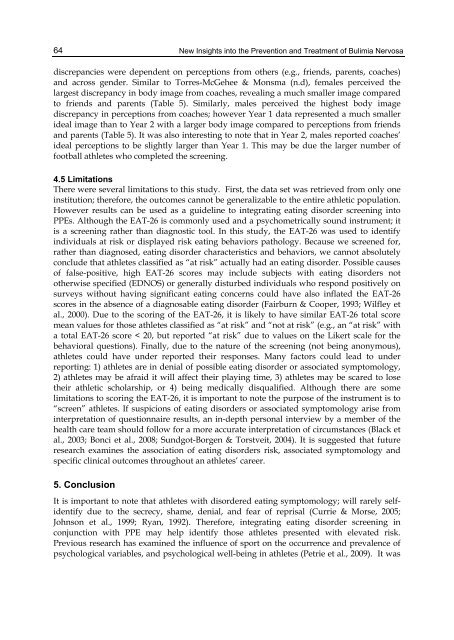new insights into the prevention and treatment of bulimia nervosa
new insights into the prevention and treatment of bulimia nervosa
new insights into the prevention and treatment of bulimia nervosa
You also want an ePaper? Increase the reach of your titles
YUMPU automatically turns print PDFs into web optimized ePapers that Google loves.
64<br />
New Insights <strong>into</strong> <strong>the</strong> Prevention <strong>and</strong> Treatment <strong>of</strong> Bulimia Nervosa<br />
discrepancies were dependent on perceptions from o<strong>the</strong>rs (e.g., friends, parents, coaches)<br />
<strong>and</strong> across gender. Similar to Torres-McGehee & Monsma (n.d), females perceived <strong>the</strong><br />
largest discrepancy in body image from coaches, revealing a much smaller image compared<br />
to friends <strong>and</strong> parents (Table 5). Similarly, males perceived <strong>the</strong> highest body image<br />
discrepancy in perceptions from coaches; however Year 1 data represented a much smaller<br />
ideal image than to Year 2 with a larger body image compared to perceptions from friends<br />
<strong>and</strong> parents (Table 5). It was also interesting to note that in Year 2, males reported coaches’<br />
ideal perceptions to be slightly larger than Year 1. This may be due <strong>the</strong> larger number <strong>of</strong><br />
football athletes who completed <strong>the</strong> screening.<br />
4.5 Limitations<br />
There were several limitations to this study. First, <strong>the</strong> data set was retrieved from only one<br />
institution; <strong>the</strong>refore, <strong>the</strong> outcomes cannot be generalizable to <strong>the</strong> entire athletic population.<br />
However results can be used as a guideline to integrating eating disorder screening <strong>into</strong><br />
PPEs. Although <strong>the</strong> EAT-26 is commonly used <strong>and</strong> a psychometrically sound instrument; it<br />
is a screening ra<strong>the</strong>r than diagnostic tool. In this study, <strong>the</strong> EAT-26 was used to identify<br />
individuals at risk or displayed risk eating behaviors pathology. Because we screened for,<br />
ra<strong>the</strong>r than diagnosed, eating disorder characteristics <strong>and</strong> behaviors, we cannot absolutely<br />
conclude that athletes classified as “at risk” actually had an eating disorder. Possible causes<br />
<strong>of</strong> false-positive, high EAT-26 scores may include subjects with eating disorders not<br />
o<strong>the</strong>rwise specified (EDNOS) or generally disturbed individuals who respond positively on<br />
surveys without having significant eating concerns could have also inflated <strong>the</strong> EAT-26<br />
scores in <strong>the</strong> absence <strong>of</strong> a diagnosable eating disorder (Fairburn & Cooper, 1993; Wilfley et<br />
al., 2000). Due to <strong>the</strong> scoring <strong>of</strong> <strong>the</strong> EAT-26, it is likely to have similar EAT-26 total score<br />
mean values for those athletes classified as “at risk” <strong>and</strong> “not at risk” (e.g., an “at risk” with<br />
a total EAT-26 score < 20, but reported “at risk” due to values on <strong>the</strong> Likert scale for <strong>the</strong><br />
behavioral questions). Finally, due to <strong>the</strong> nature <strong>of</strong> <strong>the</strong> screening (not being anonymous),<br />
athletes could have under reported <strong>the</strong>ir responses. Many factors could lead to under<br />
reporting: 1) athletes are in denial <strong>of</strong> possible eating disorder or associated symptomology,<br />
2) athletes may be afraid it will affect <strong>the</strong>ir playing time, 3) athletes may be scared to lose<br />
<strong>the</strong>ir athletic scholarship, or 4) being medically disqualified. Although <strong>the</strong>re are some<br />
limitations to scoring <strong>the</strong> EAT-26, it is important to note <strong>the</strong> purpose <strong>of</strong> <strong>the</strong> instrument is to<br />
“screen” athletes. If suspicions <strong>of</strong> eating disorders or associated symptomology arise from<br />
interpretation <strong>of</strong> questionnaire results, an in-depth personal interview by a member <strong>of</strong> <strong>the</strong><br />
health care team should follow for a more accurate interpretation <strong>of</strong> circumstances (Black et<br />
al., 2003; Bonci et al., 2008; Sundgot-Borgen & Torstveit, 2004). It is suggested that future<br />
research examines <strong>the</strong> association <strong>of</strong> eating disorders risk, associated symptomology <strong>and</strong><br />
specific clinical outcomes throughout an athletes’ career.<br />
5. Conclusion<br />
It is important to note that athletes with disordered eating symptomology; will rarely selfidentify<br />
due to <strong>the</strong> secrecy, shame, denial, <strong>and</strong> fear <strong>of</strong> reprisal (Currie & Morse, 2005;<br />
Johnson et al., 1999; Ryan, 1992). Therefore, integrating eating disorder screening in<br />
conjunction with PPE may help identify those athletes presented with elevated risk.<br />
Previous research has examined <strong>the</strong> influence <strong>of</strong> sport on <strong>the</strong> occurrence <strong>and</strong> prevalence <strong>of</strong><br />
psychological variables, <strong>and</strong> psychological well-being in athletes (Petrie et al., 2009). It was














![focuspdca.ppt [Compatibility Mode]](https://img.yumpu.com/22859457/1/190x146/focuspdcappt-compatibility-mode.jpg?quality=85)


